In Kürze
Neues aus den Empa Labors
Empa-Daten für den SRF-Klimamonitor

«Am Puls des Planeten – tägliche Zahlen und Fakten zum Klima», so bewirbt die Webseite des Schweizer Radio und Fernsehens SRF seinen «Klimamonitor». Ein Teil der online publizierten Daten, nämlich die auf dem Jungfraujoch gemessenen CO2-Konzentrationen, liefern Forschende der Empa-Abteilung «Luftfremdstoffe/Umwelttechnik». Erhoben werden die Daten im Rahmen des Nationalen Beobachtungsnetzes für Luftfremdstoffe (NABEL) und der europäischen Forschungsinfrastruktur «Integrated Carbon Observation System» (ICOS) an der Forschungsstation auf dem Jungfraujoch.
Hightech-Anlage für filigrane Strukturen
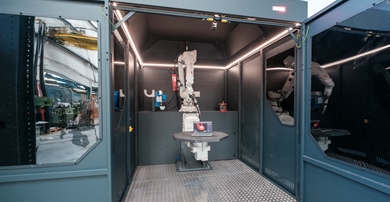
«Wire-Arc Additive Manufacturing» (WAAM) ist eine Methode zur Herstellung grosser und komplexer Metallbauteile wie Brücken, Metallträger und -stützen oder Stahlverstärkungen für komplexe Betonformen. Mit dieser innovativen Technik – einer Mischung aus robotergestütztem 3D-Druck und Lichtbogenschweissen – wollen Empa-Forschende dazu beitragen, solche grossen Metallstrukturen zu optimieren und den Energie- und Ressourcenbedarf für ihre Herstellung zu senken.
Forschung für Kinder: Was Eis übers Klima weiss
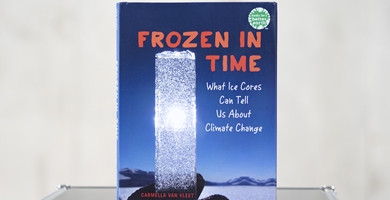
Eisbohrkerne sind ein einmaliges Klimaarchiv. Empa-Forschende aus dem Labor «Luftfremdstoffe / Umwelttechnik» arbeiten an Methoden, um Treibhausgaskonzentrationen in solchen gefrorenen Proben eakt zu bestimmen. Dafür waren sie auch schon auf Antarktis-Expeditionen. Während einer solchen Expedition fotografierte Bernhard Bereiter, damals Postdoktorand an der Empa, einen Eiskern im Sonnenlicht. Nun ziert sein Bild das Cover des Buchs «Frozen in Time» der amerikanischen Autorin Carmella Van Vleet, das Schulkindern Klimaforschung anhand von Eisbohrkernen näherbringt.
Luftfremdstoffe / Umwelttechnik
'Frozen in Time' von 'Carmella Van Vleet' - eBook (orellfuessli.ch)
Bessere Kalibrierung für schnellere Diagnostik
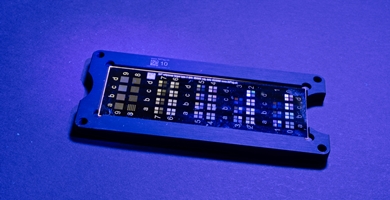
DNA-Sequenzierung und Fluoreszenzmikroskopie sind wichtige Verfahren Medizin und Forschung. Damit lassen sich Krankheiten genau diagnostizieren, Zellen und Gene durchleuchten und personalisierte Therapien entwickeln. Die hochempfindlichen Geräte, die man dafür braucht, funktionieren allerdings nur dann zuverlässig, wenn sie präzise eingestellt und kalibriert sind. Empa-Forschende aus dem Labor «Surface Science & Coating Technologies» haben in Zusammenarbeit mit der Firma IMT AG aus Greifensee besondere Kalibrationstargets für DNA-Sequenzierer und Fluoreszenzmikroskope entwickelt, dank denen die Systeme schneller und zuverlässiger arbeiten.
Surface-Science-and-Coating-Technologies Laboratory
«Save the Date»: Tag der offenen Tür an der Empa in Dübendorf

On Saturday, 14 September 2024, Empa opens its doors for an Open Lab Day in Dübendorf. Visitors can get to know the new Empa and Eawag campus, co-operate, and immerse themselves in the world of materials science and technology at Empa. There will be numerous booths, demonstrators and lectures for young and old on the topics of climate change, energy transition, dwindling resources, fascinating materials and healthy life in a healthy environment. Visitors will also gain an insights into the demonstrators NEST, move, ehub and WaterHub, and learn more about apprenticeships at Empa. Interested? Find out more about the event online and in the next issue of Empa Quarterly. More information: Openday
Rückenschmerzen dynamisch verstehen
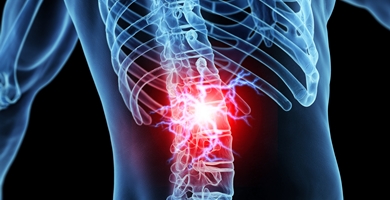
Musculoskeletal disorders are the second most common cause of disability worldwide. In order to provide early and effective treatment, we need to better understand the interplay between complex biochemical processes and the body's biomechanics. The pain often only occurs when patients are in motion – and yet, the diagnosis is mainly made using static images. An Empa team wants to change this in a newly launched two-year project involving scientists from the Mechanical Systems Engineering laboratory, the Center for X-ray Analytics and Scientific IT, as well as clinical partners at Inselspital Bern. The aim is to improve the diagnosis of a painful degenerative disease of the spine known as lumbar spinal stenosis using a combination of biomarkers, X-ray images in motion and 3D imaging of muscles and ligaments. In parallel, the researchers also want to develop a secure platform for the management of clinical data.
More information: Dynamic imaging center
Das Bildungslabor wächst
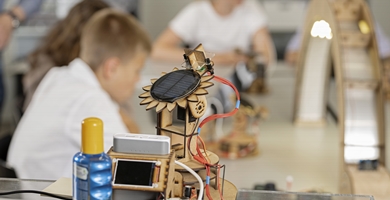
With the support of the IT education campaign, the Smartfeld education lab is expanding its range of services. Pupils from the Werdenberg-Sarganserland and Lake Zurich-Linth regions can now attend STEM workshops on site in Buchs and Rapperswil-Jona, in addition to the location at the Switzerland Innovation Park OST in St. Gallen. The interdisciplinary education initiative was co-started by Empa, among others, in 2018. Empa researchers develop STEM demonstrators for Smartfeld, which are then manufactured at Empa in collaboration with the institute's apprentices. In 2023, Smartfeld attracted well over 4,000 students and more than 300 teachers for workshops and courses.
More information: Home | Smartfeld | Technologie + Kreativität
Fahrzeugreifen als Quelle von Mikroplastik
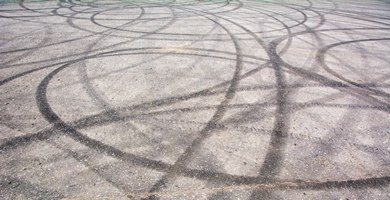
If you brake hard in a car, the tires will leave a black mark on the road. Tire wear is, however, not only generated during extreme manoeuvers, but also during every "normal" drive; even at constant speed, the tires rub against the road surface, releasing tire material into the environment. This material accounts for a large proportion of the total released microplastics. In a recently published report in response to a postulate from the Swiss parliament, researchers from Empa and the company wst21 summarized the results of numerous studies and presented approaches on how tire wear can be reduced.
More information: Empa - Communication - Mikroplastik-Reifen-Abrieb
STEP2: Baustart für neue NEST-Unit

Construction is underway, once again, at the research and innovation building NEST. The new unit goes by the name of STEP2. Over the past three years, project partners from various disciplines have developed innovations with high market potential, which will be implemented in a real-world construction project for the very first time, such as the newly designed ribbed filigree ceiling, a digitally constructed concrete staircase or an innovative façade system. STEP2 is scheduled to be completed in spring 2024.
Bewegte Röntgenbilder: «Dynamic Imaging Center» in Bern eröffnet

At the beginning of November, the Dynamic Imaging Center (DIC) was opened at sitem-insel, the Swiss Institute for Translational Medicine and Entrepreneurship. It is the first customized laboratory of its kind in Europe to be operated in a clinical environment. Here, X-ray images of a moving person can be taken simultaneously from two different directions. This is unique in Europe and a milestone in the investigation of musculoskeletal disorders. The center is a collaboration between sitem-insel, Inselspital/Bern University Hospital and Empa.
«Bright Minds»: Helle Köpfe an der Empa: Spezialausgabe «Mining the Atmosphere»

In the future, excess man-made CO2 is to be captured from the atmosphere and converted into valuable materials such as building materials or polymers. This is the goal of Empa's new research initiative: Mining the Atmosphere. A special edition of Bright Minds: Bold Ideas. Smart Materials. is dedicated to this vision – from CO2 capturing to converting carbon into innovative materials. This special edition kicks off with Nathalie Casas, head of the Department Energy, Mobility and Environment, together with Peter Richner, head of the Department Engineering Sciences. In the first episode, the two shed light on the potential of this promising vision as well on the hurdles and challenges.
Treibhausgase weltweit überwachen

In order to better understand climate change, we need to know the concentration and distribution of greenhouse gases in the atmosphere as accurately as possible. The Global Greenhouse Gas Watch (GGGW) is an initiative of the World Meteorological Organization (WMO) for the development of a global infrastructure for measuring and monitoring greenhouse gases. Empa researchers from the Air Pollutants / Environmental Technology lab are playing a key role in this. Central to this is WMO's Global Atmosphere Watch program. Empa operates a world calibration center for the gaseous components in this program. Among other things, Empa carries out audits and provides training and support for measuring stations around the world. It thus ensures that all partners provide reliable and comparable data and promotes the international exchange of knowledge in the field of atmospheric research.
Aus Vision wird Innovation

In BASF's "Schweizer Macher" podcast, Empa Director Tanja Zimmermann talks about her vision for Empa as a "beacon for new materials and technologies" and about inspiring ideas for a sustainable future. She also reveals how innovations are created at Empa, how much diversity contributes to this process, and what we can learn from science fiction. The episode (in German) is available on Spotify, Apple Podcasts and on the web.
Neuer Leiter des «Urban Energy Systems»-Labors

Starting in October, Georgios Mavromatidis will take over as head of the Urban Energy Systems lab. He will succeed Kristina Orehounig, who will be joining the Vienna University of Technology as a professor in the research area of building physics and building ecology. Currently a senior researcher at ETH Zurich, Mavromatidis has previously been a postdoc at the lab he is now to lead, doing research on multi-energy systems and building energy efficiency. He holds a doctorate in Energy Systems Modelling from ETH Zurich, an MSc in Sustainable Energy Futures from Imperial College London and a Diploma in Mechanical Engineering from Aristotle University of Thessaloniki.
«Bright Minds»: Den Batteriemarkt revolutionieren

Safer and longer-lasting lithium-ion batteries, which can also be manufactured much more sustainably, are soon expected to revolutionize the battery market. Developing such game-changing solutions is no walk in the park. Empa scientists take on that formidable task – and they deliver! High time to put the limelight on the faces behind the novel materials and technologies from our labs: The new video series "Bright Minds: Bold Ideas. Smart Materials" will give you insights about our researchers' journeys and their paths to discoveries all the way to the translation into practical applications. In the current episode, Empa researcher and spin-off co-founder Abdessalem Aribia highlights the challenges and successes in developing this promising battery technology.
Lichtsignal für bessere Luft

The "Wuerfeli" makes air quality visible. The small sensor measures the CO2 concentration in indoor air and indicates by its color when it is time to ventilate. Moreover, the small pyramid measures parameters such as temperature, relative humidity and air pressure. The sensor was developed with the participation of Empa as part of a large-scale study on air quality in classrooms. The result is an effective and tested air measuring device, manufactured in Switzerland. The start-up QE GmbH, based in Technopark Graubünden, produces the "Wuerfeli", which is now available online.
Neue Departementsleitung: Nathalie Casas übernimmt von Brigitte Buchmann

The Empa Directorate has appointed Nathalie Casas as a successor to Brigitte Buchmann. The chemical and bioengineer and expert in CO2 capture will take over the leadership of the department Energy, Mobility and Environment on 1 October 2023 from Brigitte Buchmann, who will retire in July. In addition to her academic track record with cutting-edge research, Nathalie Casas brings a broad range of experiences in start-ups, industry and governmental innovation promotion. Most recently, Casas headed the Research and Development department at the ETH spin-off and cleantech company Climeworks, as well as being a member of the Innosuisse Innovation Council.
Ein Kunstwerk für den Campus

The new research campus co-operate of Empa and Eawag is nearing completion. To mark the opening next year, a new work of art is to give the campus a "face". Originally from Lausanne, artist Julian Charrière won the Art competition with his sculpture group "Not to Get Lost". The composition of boulders of different sizes and stone wedges convinced the jury also because it expressed a commonality of art and science: Both disciplines pursue - albeit in different ways - the previously unexplored Stone working as one of the first cultural techniques of mankind introduced people to the divisibility of even the most solid materials. Today's research and its search for "the inside" of matter carries this cultural heritage further and into new dimensions.
Jahresbericht 2022 erschienen

2022 was a year of many changes, around the globe, in Switzerland and at Empa. In our Annual Report, we look back onto our research and our collaborations, as well as drafting our course for the future. Join us on a deep dive into the world of research and innovation and experience the broad spectrum of materials science and technology at Empa.
More information: www.empa.ch/web/s604/empa-jahresbericht-2022
Yaroslav Romanyuk übernimmt Abteilungsleitung

Yaroslav Romanyuk will take over as head of Empa's Thin Films and Photovoltaics laboratory on 1 July. He succeeds Ayodhya Tiwari, who is retiring after just over 14 years as head of the lab. Romanyuk joined Empa in 2008; since 2012, he has been a group leader in the laboratory, which he will now head. In addition to his work at Empa, he is a lecturer at ETH Zurich, EPFL and the University of Zurich. After gaining his Master's degree from the Volyn State University in Ukraine, Romanyuk obtained his doctorate from EPFL and worked as a postdoc at the University of California, Berkeley.
More information: Empa - Thin Films and Photovoltaics - Research
«Bright Minds»: Helle Köpfe an der Empa

Developing game-changing solutions for society's most pressing challenges is tough. Empa scientists take on that task – and deliver. High time to put the limelight on the faces behind the novel materials and technologies developed at Empa: A new video series – "Bright Minds: Bold Ideas. Smart Materials." will give you insights about a researcher's personal journey and their path to discoveries all the way to the translation of research in practical applications. The videos also reveal how interdisciplinary teamwork at Empa is advancing innovation. "Bright Minds" will launch in May 2023, with Mirko Kovac and Evgeniia Gilshtein our "Sustainability Robotics" experts taking center stage.
More info on www.empa.ch/bright-minds
Computerkomponenten nach dem Vorbild von Gehirnzellen

Researchers at Empa, ETH Zurich and the "Politecnico di Milano" are developing a new type of computer component that is more powerful and easier to manufacture than its predecessors. Inspired by the human brain, it is designed to process large amounts of data fast and in an energy-efficient way. The novel component, known as a memristor, is based on halide perovskite nanocrystals, a semiconductor material known from solar cell manufacturing. The researchers manufactured the thin-film memristors at the Thin Films and Photovoltaics laboratory and investigated their physical properties at the Transport at Nanoscale Interfaces laboratory, both at Empa. Based on the measurements, they successfully simulated a complex computational task that corresponds to a learning process in the visual cortex of the brain.
More information: www.empa.ch/web/s207
Ein Kinderbuch für eine nachhaltige Zukunft

Climate crisis, loss of biodiversity, growing mountains of waste, dwindling resources: Our (one and only) home planet is in deep crisis. Research tells us what we need to do in order to build a sustainable society: limit resource consumption, circulate materials in the technosphere, and provide renewable energy for sustainable materials cycles. However, the conditions, pathways, and opportunities are not very tangible. In order to change this, Empa researchers sought out unusual collaboration partners: schoolchildren. Supported by the St. Gallen University of Teacher Education, they want to work with primary schoolchildren to develop visions for a sustainable future and compile them in an illustrated children's book. The Swiss National Science Foundation (SNSF) is supporting the project as part of its Agora program, together with the household appliance manufacturer V-Zug and the trade association SWICO.
More information: www.empa.ch/web/s506
Neue Technologie revolutioniert Analyse von altem Eis

The Beyond EPICA – Oldest Ice project, a European consortium that includes the University of Bern, aims to analyze 1.5 million year-old Antarctic ice to gather data about Earth's climate history. Such ice cores are a key climate archive. They contain air bubbles, which will allow scientists to directly measure historical greenhouse gas concentrations. However, such measurements are far from trivial. 15,000 to 20,000 years of climate history are compressed into just one meter of ice. Together with the University of Bern, Empa researchers have developed a new method to accurately analyze the ancient ice. The team led by Lukas Emmenegger, head of Empa’s Air Pollutants/Environmental Technology laboratory, developed a new laser spectrometer that can measure greenhouse gases on a sample of just 1.5 milliliters of air.
More information: www.empa.ch/web/s503
Startschuss für die Reise zu CO2-negativem Zement

The cement industry emits large amounts of climate-damaging carbon dioxide – but alternative binders based on magnesium carbonate could even bind CO2. Concrete as a carbon sink? Cements based not on limestone, aka calcium carbonate (CaCO3), but on magnesium silicates are one source of hope. A research project by Empa researcher Barbara Lothenbach, who recently received one of the first Advanced Grants from the Swiss National Science Foundation (SNSF), is to lay the foundations for this as of early next year. Unlike conventional cements, whose hardening has been investigated down to the tiniest details, these materials still raise many questions. In seven focal areas, Empa experts and partners from the Finnish University of Oulu will thus explore what is happening at the molecular level. How do such cements harden and with which formulations? What is the effect of temperature, pH and other factors such as reaction accelerators? Does the volume of magnesium concrete remain stable over the long term? And how resistant is it? In the end, the findings from laboratory tests and thermodynamic modeling should flow into a digital twin of magnesium carbonate cement – a simulation of the processes involved in hardening and the basis, Empa experts hope, for formulations of robust concretes that bind as much CO2 as possible.
Further information: /web/s308
Erfolgreiche Finanzierungsrunde für Empa-Spin-off

The company Nahtlos, an Empa spin-off, has received one million Swiss francs in a first round of financing from a network of business angels from Switzerland and Liechtenstein and from the Startfeld Foundation. This is intended to drive the market entry of an innovative textile-based electrode for medical applications. In the past two years, the company had developed such components, among other things for recording heart activity through electrocardiograms (ECG) – for example, to be able to detect atrial fibrillation. Textile-based electrodes enable gentle and skin-friendly application, even if the electrodes have to be worn for several days or even weeks. They are thus a real alternative to the gel electrode, which was developed 60 years ago and is still considered the standard for medical applications today.
Further information: https://www.nahtlos.com/
Wasser-aktivierte Papierbatterie unter weltbesten Erfindungen

A team led by Gustav Nyström from Empa's Cellulose & Wood Materials Laboratory has made it onto the list of the 200 most important inventions published by Time magazine – with its biodegradable disposable battery, the function of which is triggered by adding a bit of water. The jury awarded the prize to the Empa team in the "Experimental" category; the jury evaluates inventions according to originality, creativity, efficiency, impact and other criteria. The battery developed by Nyström's team consists of at least one electrochemical cell measuring around one square centimeter. What makes it special is that the fact that both paper and zinc and the other components are biodegradable could significantly minimize the environmental impact of disposable electronics with low power consumption – an important step towards green electronics.
Further information: /web/s302






